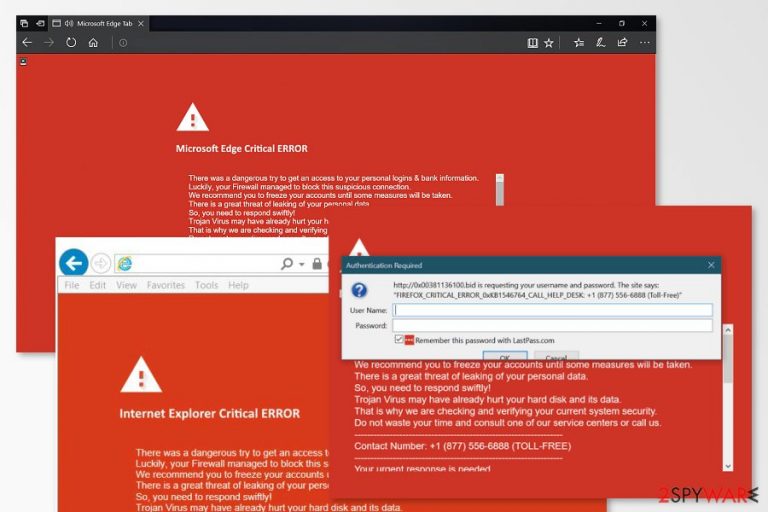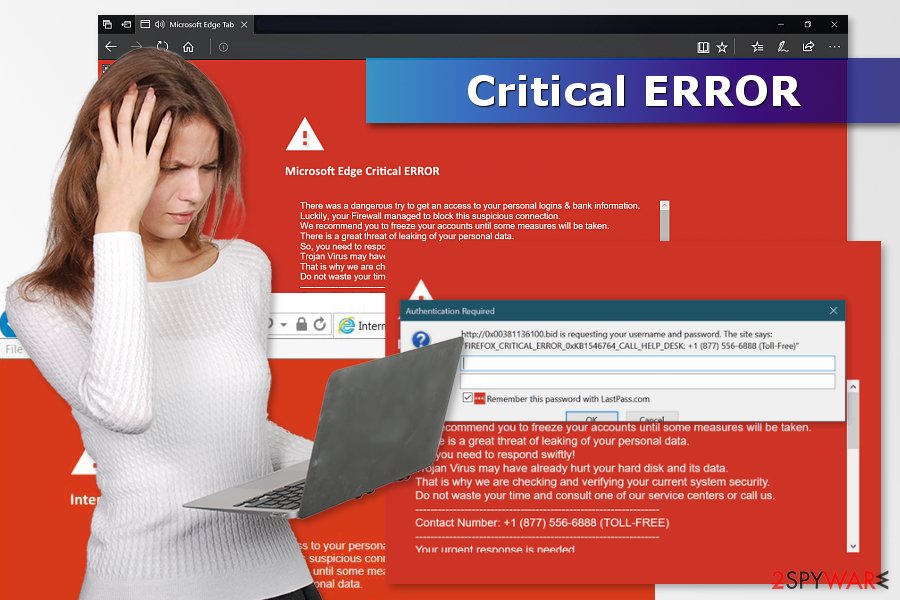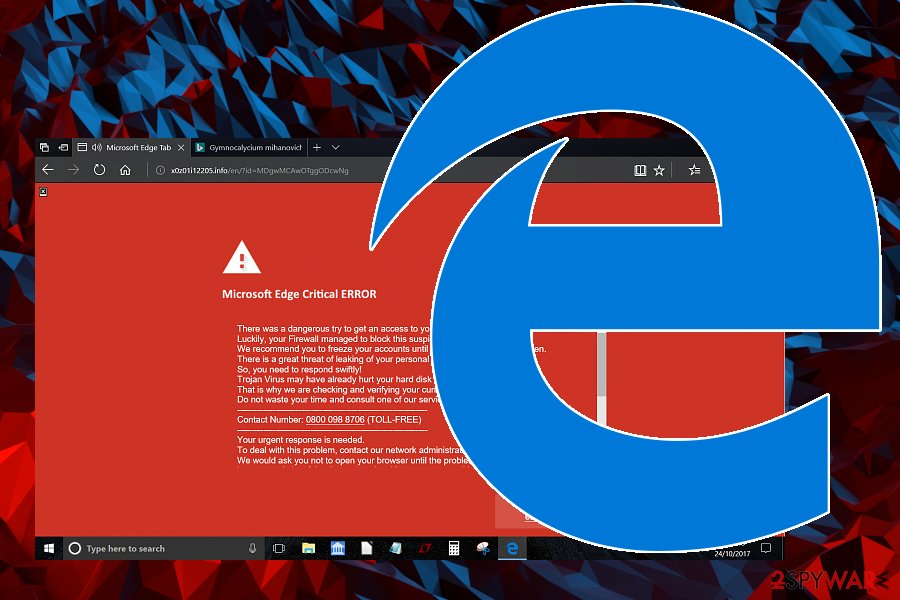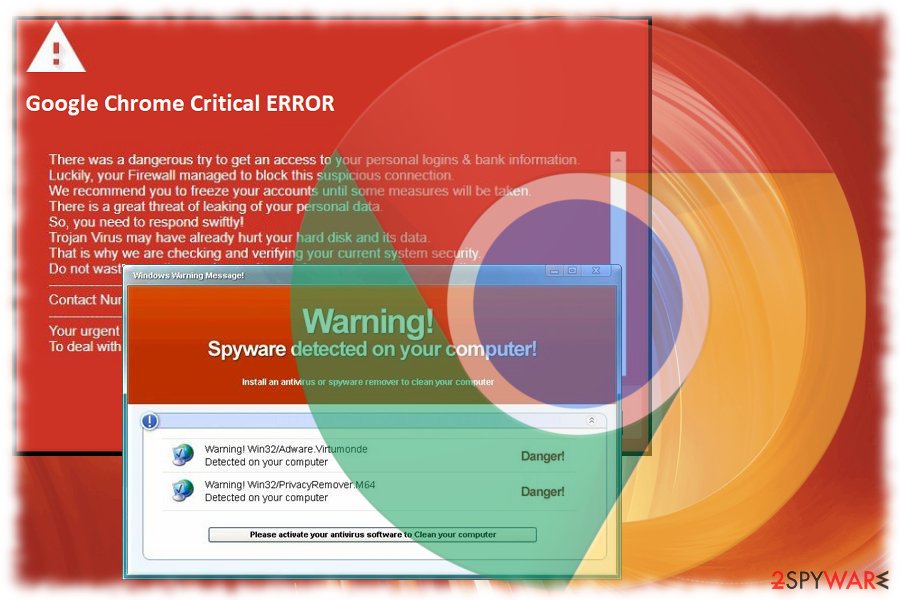Critical ERROR scam (Red screen virus)
Critical ERROR scam Removal Guide
What is Critical ERROR scam?
Critical ERROR virus is a tech support scam campaign that aims to trick people into revealing their personal details

Critical ERROR is a scam that has nothing to do with Microsoft. This red screen message has been used to scare people about invented problems on Google Chrome, Microsoft Edge, Mozilla Firefox, and other web browsers. While trying to mislead users into thinking that their personal information is in danger, scammers display a red screen error that shows up on the screen while they browsing the Internet. Please, do NOT fall for Google Chrome critical error and similar scams because they belong to scammers who will do their best to steal your money, credit card details, and other personal information or infect your PC with malware.
| Name | Critical ERROR scam |
|---|---|
| Type | Tech support scam/virus |
| Versions appear in |
|
| Symptoms | Causes a red warning message on the affected browser, which reports about the risk of identity theft. Pushes victim into contacting certified Microsoft's technicians who are all fake |
| Numbers used by this scam |
|
| removal | Use anti-malware tools to check the system for adware-type viruses causing the fake error messages on your screen |
| repair | Various changes and alterations were done to preferences and settings on the system can lead to issues with the performance. Run FortectIntego to find and repair any occurred damage |
Users might become victims of the tech support scam[1] while they are browsing on infected or high-risk websites. However, if the browser continuously opens a new tab or window with this site, it’s definitely caused by the potentially unwanted program (PUP), usually adware.
The Critical ERROR red screen virus is designed to redirect users to a corrupted website that delivers a message warning about computer infection and urges them to call a provided phone number. Criminals might pretend to be official Microsoft support technicians and:
- sell you useless security software to get your credit card information;
- convince you into installing remote access software to solve the problem quicker;
- download malware, ransomware,[2] or spyware into your computer.
Scammers are great in human psychology and can use social engineering perfectly. Thus, you may not notice how you follow their demands and give everything they ask for. For this reason, you should not call them even for fun. If redirects continue, you should take all necessary measures to remove the virus from the device.
In order to clean the computer quickly and without putting too much effort, you should take advantage of professional anti-malware software. Anti-malware such as SpyHunter 5Combo Cleaner, Malwarebytes is a perfect choice for Critical ERROR removal.

Versions of Critical ERROR scam
Mozilla Firefox Critical ERROR. This version of the tech support scam is designed to trick Firefox users that their personal data is in danger. The malicious website delivers a fake authentication box that requires entering a username and password. However, none of your current credentials will work. It’s trickery that is supposed to convince you into calling a fake support line.
Crooks are known for using +1 (877) 556-6888 and +1 (877) 777-8951 numbers. The message itself might also provide an error code. Currently, it delivers system errors 0xKB1546764 and 0xKB6301092. However, none of them are real, and calling provided number is not recommended.
Internet Explorer Critical Error. IE users might be tricked that their computers are infected with RDN/Trojan.worm![rand]. In order to protect their passwords, browsing-related information, browsing history, identity, and credit card information from being exposed or sold, users have to call +1 888 780 0587.
However, this number does not belong to Microsoft Technical Support, as the message says. Therefore, the call might be expensive (even if it says it’s toll-free), crooks might actually swindle your sensitive data, money, or get access to your computer.

Microsoft Edge Critical ERROR. Cybercriminals pretend to be official Microsoft technicians that report about detected viruses on the computer. This alleged system error also asks to call a toll-free number 1-844-734-4622 in order to get needed help to fix the computer.
However, Microsoft does not deliver security alerts on Microsoft Edge. Thus, this pop-up is created by cybercriminals that have hidden purposes, such as selling you useless security software or getting remote access to your PC, and installing malware.
Google Chrome Critical Error. Chrome is the most popular web browser, so there's no surprise that Chrome users can receive a Critical Error alert too. This version of the tech support scam barely differs from the previous ones. Scammers threaten that user's private information might be in danger, and they need to call + 1 (888) 562-5234 phone number to get needed help.
However, redirects to a malicious website that delivers a fake critical error pop-up are usually triggered by adware. Thus, users are advised to check the computer’s security and eliminate the potentially unwanted program to stop this activity. Hence, calling a fake “Help Desk” won't help to solve the problem.

Users fall into installing adware because of a lack of attention
As you already know, various adware programs might be responsible for redirecting to the Critical system ERROR scam websites. Infiltration of the PUP might seem mysterious. However, security experts from the UK, Germany,[3] and the U.S. report that there’s no mystery; it’s only a deceptive software marketing method known as bundling.
It allows adding the PUP into the freeware or shareware package. Therefore, when a user downloads a program, he or she might install it as well. The hijack might be unexpected if you use a Standard/Recommended setup because it does not openly disclose about third-party apps. Thus, you should never rely on them.
Always install new software under Advanced/Custom settings and opt-out of all pre-selected applications. Most of them are useless, and you should not test out them.
Get rid of Critical ERROR virus from your browsers entirely by using a simple guide
To remove the virus from Internet Explorer, Microsoft Edge, Mozilla Firefox, or Google Chrome might seem like a simple task. However, you will have to find all PUPs, hijackers, and adware hiding on your system and causing fake ads while you are browsing the web. Typically, such threats infiltrate systems together with legitimate software, so there is no surprise that you can't remember downloading such a virus to your computer.
If you want to fasten the entire process, we recommend using anti-malware software. Updated security software can not only take care of Critical ERROR removal. It can also help you identify and terminate all PUPs that are considered to be suspicious. After you finish this procedure, make sure you reset your web browsers to clean them entirely.
You may remove virus damage with a help of FortectIntego. SpyHunter 5Combo Cleaner and Malwarebytes are recommended to detect potentially unwanted programs and viruses with all their files and registry entries that are related to them.
Getting rid of Critical ERROR scam. Follow these steps
Uninstall from Windows
Instructions for Windows 10/8 machines:
- Enter Control Panel into Windows search box and hit Enter or click on the search result.
- Under Programs, select Uninstall a program.

- From the list, find the entry of the suspicious program.
- Right-click on the application and select Uninstall.
- If User Account Control shows up, click Yes.
- Wait till uninstallation process is complete and click OK.

If you are Windows 7/XP user, proceed with the following instructions:
- Click on Windows Start > Control Panel located on the right pane (if you are Windows XP user, click on Add/Remove Programs).
- In Control Panel, select Programs > Uninstall a program.

- Pick the unwanted application by clicking on it once.
- At the top, click Uninstall/Change.
- In the confirmation prompt, pick Yes.
- Click OK once the removal process is finished.
Delete from macOS
Remove items from Applications folder:
- From the menu bar, select Go > Applications.
- In the Applications folder, look for all related entries.
- Click on the app and drag it to Trash (or right-click and pick Move to Trash)

To fully remove an unwanted app, you need to access Application Support, LaunchAgents, and LaunchDaemons folders and delete relevant files:
- Select Go > Go to Folder.
- Enter /Library/Application Support and click Go or press Enter.
- In the Application Support folder, look for any dubious entries and then delete them.
- Now enter /Library/LaunchAgents and /Library/LaunchDaemons folders the same way and terminate all the related .plist files.

Remove from Microsoft Edge
Delete unwanted extensions from MS Edge:
- Select Menu (three horizontal dots at the top-right of the browser window) and pick Extensions.
- From the list, pick the extension and click on the Gear icon.
- Click on Uninstall at the bottom.

Clear cookies and other browser data:
- Click on the Menu (three horizontal dots at the top-right of the browser window) and select Privacy & security.
- Under Clear browsing data, pick Choose what to clear.
- Select everything (apart from passwords, although you might want to include Media licenses as well, if applicable) and click on Clear.

Restore new tab and homepage settings:
- Click the menu icon and choose Settings.
- Then find On startup section.
- Click Disable if you found any suspicious domain.
Reset MS Edge if the above steps did not work:
- Press on Ctrl + Shift + Esc to open Task Manager.
- Click on More details arrow at the bottom of the window.
- Select Details tab.
- Now scroll down and locate every entry with Microsoft Edge name in it. Right-click on each of them and select End Task to stop MS Edge from running.

If this solution failed to help you, you need to use an advanced Edge reset method. Note that you need to backup your data before proceeding.
- Find the following folder on your computer: C:\\Users\\%username%\\AppData\\Local\\Packages\\Microsoft.MicrosoftEdge_8wekyb3d8bbwe.
- Press Ctrl + A on your keyboard to select all folders.
- Right-click on them and pick Delete

- Now right-click on the Start button and pick Windows PowerShell (Admin).
- When the new window opens, copy and paste the following command, and then press Enter:
Get-AppXPackage -AllUsers -Name Microsoft.MicrosoftEdge | Foreach {Add-AppxPackage -DisableDevelopmentMode -Register “$($_.InstallLocation)\\AppXManifest.xml” -Verbose

Instructions for Chromium-based Edge
Delete extensions from MS Edge (Chromium):
- Open Edge and click select Settings > Extensions.
- Delete unwanted extensions by clicking Remove.

Clear cache and site data:
- Click on Menu and go to Settings.
- Select Privacy, search and services.
- Under Clear browsing data, pick Choose what to clear.
- Under Time range, pick All time.
- Select Clear now.

Reset Chromium-based MS Edge:
- Click on Menu and select Settings.
- On the left side, pick Reset settings.
- Select Restore settings to their default values.
- Confirm with Reset.

Remove from Mozilla Firefox (FF)
Remove dangerous extensions:
- Open Mozilla Firefox browser and click on the Menu (three horizontal lines at the top-right of the window).
- Select Add-ons.
- In here, select unwanted plugin and click Remove.

Reset the homepage:
- Click three horizontal lines at the top right corner to open the menu.
- Choose Options.
- Under Home options, enter your preferred site that will open every time you newly open the Mozilla Firefox.
Clear cookies and site data:
- Click Menu and pick Settings.
- Go to Privacy & Security section.
- Scroll down to locate Cookies and Site Data.
- Click on Clear Data…
- Select Cookies and Site Data, as well as Cached Web Content and press Clear.

Reset Mozilla Firefox
If clearing the browser as explained above did not help, reset Mozilla Firefox:
- Open Mozilla Firefox browser and click the Menu.
- Go to Help and then choose Troubleshooting Information.

- Under Give Firefox a tune up section, click on Refresh Firefox…
- Once the pop-up shows up, confirm the action by pressing on Refresh Firefox.

Remove from Google Chrome
Delete malicious extensions from Google Chrome:
- Open Google Chrome, click on the Menu (three vertical dots at the top-right corner) and select More tools > Extensions.
- In the newly opened window, you will see all the installed extensions. Uninstall all the suspicious plugins that might be related to the unwanted program by clicking Remove.

Clear cache and web data from Chrome:
- Click on Menu and pick Settings.
- Under Privacy and security, select Clear browsing data.
- Select Browsing history, Cookies and other site data, as well as Cached images and files.
- Click Clear data.

Change your homepage:
- Click menu and choose Settings.
- Look for a suspicious site in the On startup section.
- Click on Open a specific or set of pages and click on three dots to find the Remove option.
Reset Google Chrome:
If the previous methods did not help you, reset Google Chrome to eliminate all the unwanted components:
- Click on Menu and select Settings.
- In the Settings, scroll down and click Advanced.
- Scroll down and locate Reset and clean up section.
- Now click Restore settings to their original defaults.
- Confirm with Reset settings.

Delete from Safari
Remove unwanted extensions from Safari:
- Click Safari > Preferences…
- In the new window, pick Extensions.
- Select the unwanted extension and select Uninstall.

Clear cookies and other website data from Safari:
- Click Safari > Clear History…
- From the drop-down menu under Clear, pick all history.
- Confirm with Clear History.

Reset Safari if the above-mentioned steps did not help you:
- Click Safari > Preferences…
- Go to Advanced tab.
- Tick the Show Develop menu in menu bar.
- From the menu bar, click Develop, and then select Empty Caches.

After uninstalling this potentially unwanted program (PUP) and fixing each of your web browsers, we recommend you to scan your PC system with a reputable anti-spyware. This will help you to get rid of Critical ERROR scam registry traces and will also identify related parasites or possible malware infections on your computer. For that you can use our top-rated malware remover: FortectIntego, SpyHunter 5Combo Cleaner or Malwarebytes.
How to prevent from getting malware
Access your website securely from any location
When you work on the domain, site, blog, or different project that requires constant management, content creation, or coding, you may need to connect to the server and content management service more often. The best solution for creating a tighter network could be a dedicated/fixed IP address.
If you make your IP address static and set to your device, you can connect to the CMS from any location and do not create any additional issues for the server or network manager that needs to monitor connections and activities. VPN software providers like Private Internet Access can help you with such settings and offer the option to control the online reputation and manage projects easily from any part of the world.
Recover files after data-affecting malware attacks
While much of the data can be accidentally deleted due to various reasons, malware is one of the main culprits that can cause loss of pictures, documents, videos, and other important files. More serious malware infections lead to significant data loss when your documents, system files, and images get encrypted. In particular, ransomware is is a type of malware that focuses on such functions, so your files become useless without an ability to access them.
Even though there is little to no possibility to recover after file-locking threats, some applications have features for data recovery in the system. In some cases, Data Recovery Pro can also help to recover at least some portion of your data after data-locking virus infection or general cyber infection.
- ^ The fight against tech support scams. Microsoft blogs.The official Microsoft Blog.
- ^ Lisa Vaas. Tech support scammer tricked into installing ransomware. Naked Security. Computer security news, opinion, advice and research.
- ^ DieViren. DieViren. German cyber security news.
